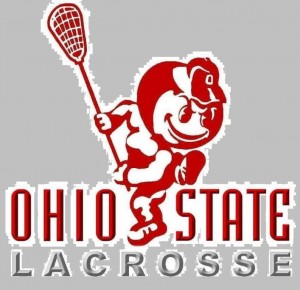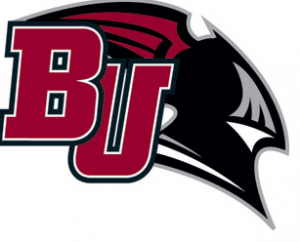This list is far more limited (two teams, plus head-to-head) than it was last year. I’ll take a look at all four teams in question in a pre-season look – and obviously go into much more detail on U-M and UDM in the run-up to the season.
Ohio State
Detroit: Feb. 9 (@ Ohio State)
Michigan: April 13 (home)
2012
8-7 (5-1 ECAC), #19 Laxpower, #14 Tempo-Free Lax
Ohio State is a pretty good team, and they’re one that is largely considered a program on the rise nationally. The Buckeyes have yet to accomplish that “breakthrough year,” but are solidly climbing the ranks of the nation’s second tier of programs. Though they lose some talent from last year’s team, they still have plenty of pieces to repeat their second-place finish in the ECAC.
The Past Results
Against the Titans last year, Ohio State played a really fast game, totaling 80 possessions. That was the fastest game for the Buckeyes all season, and fourth-fastest for UDM (the country’s second-fastest team). UDM trailed 8-3 at the half, and held OSU to a second-half deadlock en route to a final score of 11-6 in favor of the Scarlet and Gray. Scott Harris scored three goals for the Titans, while OSU’s Logan Schuss notched a quartet of tallies.
Michigan had one of their best performances of the year against Ohio State, falling by just three goals to what would end the season as a top-15 team. The Buckeyes’ Logan Schuss netted a hat trick, but ex-UM keeper Emil Weiss saved 50% of shots faced in a 12-9 loss. Alex Vasileff scored three goals for Michigan.
The Forward-Thinking Look Back
| Ohio State 2012 | |
|---|---|
| Pace | 64.53 (38) |
| Poss% | 50.93 (15) |
| Off. Eff. | 27.83 (41) |
| Def. Eff. | 22.46 (2) |
| Pyth% | 68.58 (14) |
The Buckeyes were an elite defense last year, thanks to a first-team all-conference selection in D Joe Bonnani and second-team selections D Keenan Ochwat and G Greg Dutton. Bonnani and Ochwat are out the door, so a step back here can be expected. Still the maturation of Dutton can help mitigate those two personnel losses.
The offense, on the other hand, was pretty bad. What’s most unsettling about that is that the struggles came despite the presence of the ECAC Offensive Player of the Year, attackman Logan Schuss, and ECAC All-Freshman midfielder Jesse King. Fortunately for OSU, both of those players are back, and the offense stands to improve on that basis alone.
In the possession game, the Buckeyes were (and should continue to be) middle-of-the-pack all around. Faceoff specialist Shawn Kaplan returns, but as I’ve demonstrated in the past, there’s no expectation for the same (or better) performance.
Bellarmine
Michigan: Feb. 16 (away)
Detroit: March 3 (away)
2012
4-8 (0-6 ECAC), #39 Laxpower, #40 Tempo-Free Lax
Bellarmine’s record both on the whole and in-conference were the same in 2012 as they had been the previous year, but the strength of schedule improved enough to to skyrocket their overall value to Laxpower (and TFL) from the high 40s about 10 spots. Such are the benefits of playing in a league with the national champion.
The Past Results
Of the Knights’ four wins, two came against the Michigan teams. Not happy times in the Southeast portion of the state when the boys from Kentucky come to town.
Michigan was downed first, falling in an ugly 13-9 St. Patrick’s Day clash. The Wolverines were within a goal at halftime, but Bellarmine outscored them in each of the final two quarters to pull comfortably away. Attackman Lance Robinson scored a hat trick for Bellarmine, while both Trevor Yealy and Will Meter potted a pair for U-M. It was a sloppy game, with the stats mostly in Michigan’s favor except two: faceoffs and efficiency. It was BU’s second-best defensive game of the year, behind only their slaughter of Mercer.
UDM faced Bellarmine when the Titans’ season had already started spiraling out of control. This was the straw that truly broke the camel’s back. Detroit led 8-4 with under four minutes left, and managed to lose 9-8 in regulation. That’s pitiful late-game defense if I’ve ever heard of it. Shayne Adams did manage to score a hat trick for the Titans, but the team output was obviously one goal short.
The Forward-Thinking Look Back
| Bellarmine 2012 | |
|---|---|
| Pace | 65.92 (31) |
| Poss% | 48.42 (47) |
| Off. Eff. | 27.86 (40) |
| Def. Eff. | 30.58 (33) |
| Pyth% | 38.11 (40) |
Bellarmine’s offense was exactly one position nationally behind Ohio State’s (funny what effect an elite defense can have on your team’s success), slightly below-average in the country. Leading goal-scorer Michael Ward is back for his senior season in the attack, but leading point-getter Colton Clark is gone. This was not a deep unit, but most of the top six scorers – those who put up double-digits – are back (No. 3 scorer Austin Bright is also gone).
The defense was mediocre. Mediocre will win lots of games in weaker conferences, but paired with a poor offense, it wasn’t enough to keep the ship afloat. The lone All-ECAC player was all-freshman team member Bobby Schmitt, an LSM. Defensemen Matt Silvia, Ross Doan, and Arden Wipf all depart, so it should be tough times for goalkeeper Dillon Ward.
Bellarmine was a poor faceoff team, with Troy Athens alum Andrew Bulgarelli struggling while taking most of the draws. Regression (progression?) to the mean can be expected.
Head-to-Head
April 17 (@ Michigan)
2012
Michigan: 1-13, #58 Laxpower, #59 Tempo-Free Lax
Detroit: 6-9 (3-3 MAAC), #52 Laxpower, #50 Tempo-Free Lax
I’ll spend a lot of time talking about these two squads in the coming days, so no need to get overly verbose here. Detroit entered the year with high expectations – including a potential MAAC Championship – and while Michigan’s goals weren’t so lofty, winning more than one game was certainly the expectation.
The Past Result
The two teams met in Michigan’s first-ever game last February (and Detroit’s third contest of the season). The Wolverines didn’t come out with nerves, however, racing to leads of 2-0 and 4-2 early in the second quarter. From there, however, the experience of the Titans came to life.
UDM scored in runs of two (twice), three, and four goals in the course of the game – a theme for Michigan’s defense throughout the year, actually – and led 12-7 almost midway through the fourth. Thomas Paras drew things within four goals, but a Tim Lehto unassisted tally closed the door on any comeback attempts, and a Thomas Paras goal with under a minute left served to do little more than make the score look a bit nicer.
If the teams’ schedules had been reversed – if Michigan had taken on two highly ranked and highly skilled opponents while UDM was getting their first action of the year – it might have been a little closer, but the Titans’ experience (one player on Michigan’s roster last season had ever played Division I ball, while obviously every non-freshman on the UDM squad had a year of varsity under their belt) was too much for Michigan to overcome.
Stay tuned in coming days, when I’ll run down the rest of the schedules for each team, and then get into full-on season previewin’ mode.



The Titans have a few avenues by which they could see some improvement, and I’m willing to bet that at least two of them will indeed get better in 2012 (wing play, and the play of Brandon Davenport). The other two are wildcards, but considering that they can only make things better, not any worse – whereas Davenport or MacLean could theoretically perform worse, and wing play could theoretically get worse, any new person on faceoffs who doesn’t get it done will quickly see the bench – I predict the Titans will near 50% at the faceoff X next season, and will be much better in the overall possession game as a result.
I’ve examined faceoff numbers in-depth in the past, and the data doesn’t really support (contrary to my expectations) that wing play or FOGO play can only get better. There was actually very little improvement in teams’ and individuals’ faceoff performances year-over-year.